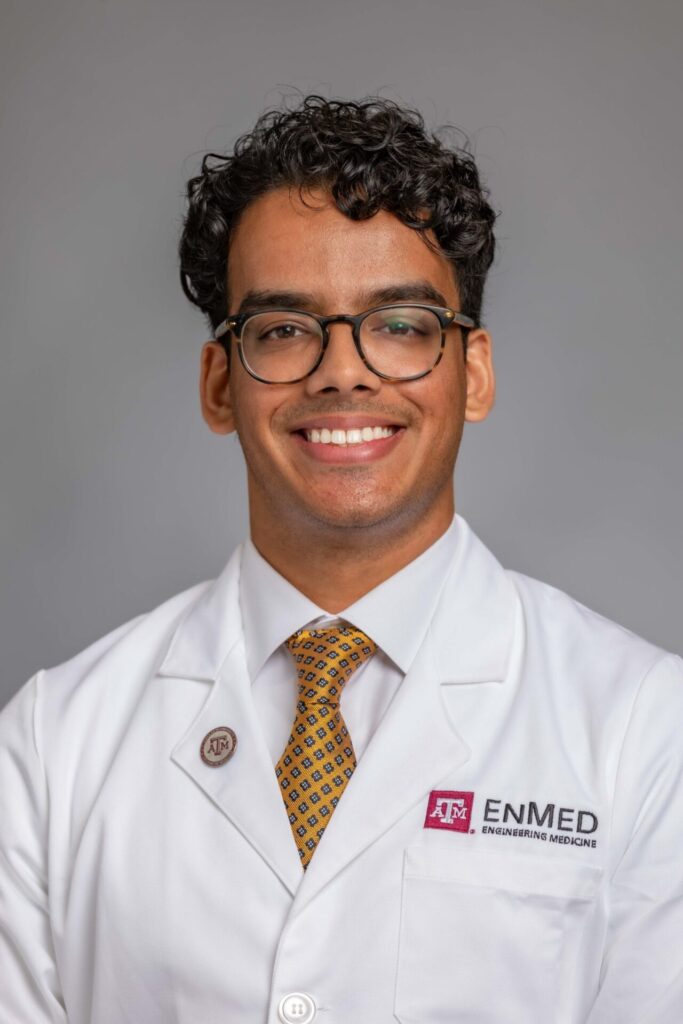
Focused, ambitious, and creative M2 student Basil Alias excites at the treasures of his most successful EnMed Innovation Project (IP) and eagerly awaits the future and potential of his design.
Alias jumps at every opportunity to better a process in health care, assist his peers in research and innovation, and create something both useful and unique to the world of medicine. Having created and assisted numerous IP’s, Alias continues to dip his foot in every field of innovation and health care and thrives in creating better care for patients. At the start of his EnMed journey, Alias found himself in the world of cardiology, seeking solutions for patients who show issues with blood clotting.
When patients present a problem with excessive blood clotting, doctors prescribe blood thinners to their patients, running through a series of tests to find the correct dosage of medication. However, blood thinners come with a risk of over correction where the blood does not clot very well, leading to uncontrollable bleeding. To reduce this complication, physicians will reduce the dosage and insert an Inferior Vena Cava (IVC) filter inside of the patient’s body. An IVC filter is a small, wiry netting
device used to capture blood clots from the lower extremities, before they travel to the heart or lungs.
Even with the creative design of the device, there is no guarantee that the IVC filter will work in the long run because of the lack of exact mapping of the cross-section of the IVC filter. Alias understood the difficulty with IVC filters, stating that “There is still so much unknown of its effectiveness and complexities. I wanted to create something that guaranteed effectiveness.” To ensure a reliable and effective reading for the physician, Alias used a method and principle not typically seen in the realm of health care to create his design.
The oil and gas field rarely makes ties with that of engineering medicine, but Alias discovered that a few of their methodologies may be more than useful to the health care community than most have realized. In the oil industry, geophysicists work with landmen to inject electrical currents through the ground to find cavities of oil. In a similar fashion, Alias uses this method to create a device that will pump electrical signals through the extremities of the patient, helping doctors determine the correct dosage of medication the patient would need, and assist in titrating the blood, reducing the number of clots and lower the chances of excess bleeding.
Adopting this methodology from the oil industry, Alias wanted to create a more effective solution for patients, and a more reliable reading for physicians. “By injecting electrical signals through the arms of the IVC filter, the device can generate images of the cross-section of the filter, showing the size of clots that pass through or are caught by the IVC filter,” stated Alias, “It can detect blood flow, stenosis or blockage, implant migration, as well as quantify the number of clots a patient is generating over time, and narrow down the amount of medication a patient needs.” Physicians would now have access to read the mappings of the cross-section of the IVC filter and prescribe them medication with little difficulty.
Alias took his research and unique invention to Texas A&M University patent offices and after multiple meetings with business professionals, Alias is now seeking funding for his work and in the process of receiving a full patent for his design. “What started as something small was now becoming larger than I could have ever imagined,” said Alias, “I am able to change health care in way that would last.” Already a huge success, Alias plans on applying the same technology to detect kidney stones, track organ health during transport and transplant, and vascular perfusion monitoring and more.
Only in his second year of medical school, Alias has already left a mark on EnMed and is determined to continue innovating health care to his fullest extent. As he begins his third year, Alias states that “I want to be a part of this new world of health care—I have to see it through.” EnMed is excited for his next steps, as they know he will make the world of engineering medicine better than it was before.